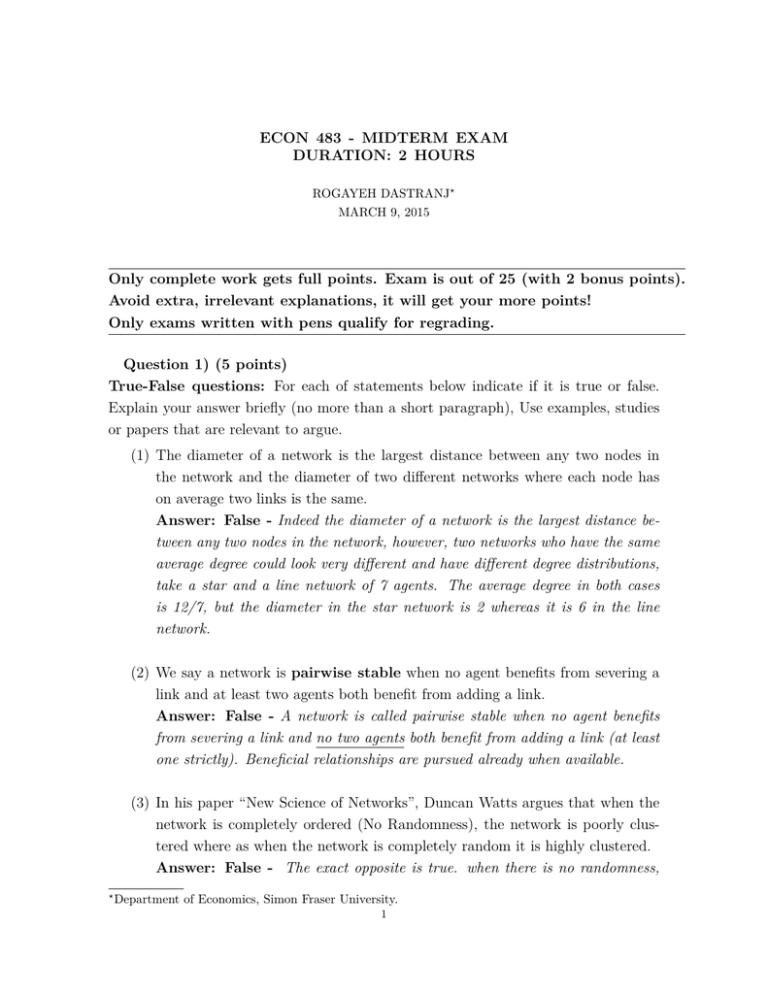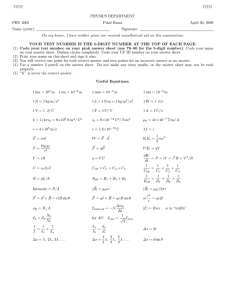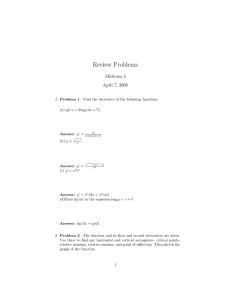ECON 483 - MIDTERM EXAM DURATION: 2 HOURS
advertisement

ECON 483 - MIDTERM EXAM DURATION: 2 HOURS ROGAYEH DASTRANJ? MARCH 9, 2015 Only complete work gets full points. Exam is out of 25 (with 2 bonus points). Avoid extra, irrelevant explanations, it will get your more points! Only exams written with pens qualify for regrading. Question 1) (5 points) True-False questions: For each of statements below indicate if it is true or false. Explain your answer briefly (no more than a short paragraph), Use examples, studies or papers that are relevant to argue. (1) The diameter of a network is the largest distance between any two nodes in the network and the diameter of two different networks where each node has on average two links is the same. Answer: False - Indeed the diameter of a network is the largest distance between any two nodes in the network, however, two networks who have the same average degree could look very different and have different degree distributions, take a star and a line network of 7 agents. The average degree in both cases is 12/7, but the diameter in the star network is 2 whereas it is 6 in the line network. (2) We say a network is pairwise stable when no agent benefits from severing a link and at least two agents both benefit from adding a link. Answer: False - A network is called pairwise stable when no agent benefits from severing a link and no two agents both benefit from adding a link (at least one strictly). Beneficial relationships are pursued already when available. (3) In his paper “New Science of Networks”, Duncan Watts argues that when the network is completely ordered (No Randomness), the network is poorly clustered where as when the network is completely random it is highly clustered. Answer: False - The exact opposite is true. when there is no randomness, ? Department of Economics, Simon Fraser University. 1 ECON 483 - MIDTERM EXAM DURATION: 2 HOURS 2 the clustering is high and the network is rather large (large diameter), but when the network is completely random, the network is poorly clustered and it has a small diameter. (4) Based on the “Strength of weak ties” paper, individuals with many strong ties are best placed to diffuse a difficult innovation, since some of those ties will be local bridges. Answer: False - This paper argues that weak links could act as bridges and individuals with many weak links are best placed to diffuse information and innovation (5) Homophily refers to a tendency of various types of individuals to associated with others who are similar to themselves and always contributes to a faster spread of information. Answer: False - Homophily does not always contribute to faster spread of information. In fact, sometime the information may never reach a group of people if the network has a very strong component structures (formed based on individuals preferences) with very few or no links between components. Question 2) (3 points) (1) When is a network called a Connected Network? Answer: Network (N, g) is Connected if every two nodes are connected by some path in the network. (2) Intuitively define component of a network and explain why knowing the component strutter of the network matter? Answer: A component is a maximal connected subgraph, such that if two agents are connected by a link they both belong to the same component. Also, a completely isolated node that has no links is considered a component. In many applications such as contagion, learning, diffusion of various behaviours, etc. it is important to track which nodes can reach which other nodes through a path. ECON 483 - MIDTERM EXAM DURATION: 2 HOURS 3 Question 3) (8 points) Consider the network below and answer all the following questions: (1) Calculate the Betweenness Centrality for individuals 2 & 5. Answer: Definition of betweenness centrality is: CiB (g) = X Pi (j, k) 2 (n − 1)(n − 2) (j,k),j6=k P (j, k) Where Pi (j, k) is the number of shortest path between j, k that goes through i, and P (j, k) is the number of shortest path between j, k. Using this equation for agent 2, we see that no shortest path between any two agents in this network goes through agent 2. Therefore, agent 2’s betweenness centrality is equal to zero. Agent 5, however, is on several shortest path from agent 1, 2, 3 to agent 6, thus his centrality is: C5B (g) = 1 1 5 1 P5 (16) P5 (26) P5 (36) ( + + ) = ( + 1 + 1) = 10 P (16) P (26) P (36) 10 2 20 (2) Calculate the Closeness Centrality for individuals 3 & 1. Answer: Definition of closeness centrality is: n−1 CiC (g) = P j l(i, j) Where l(i, j) is the length of shortest path between i, j. Therefore, 5 5 = 1+1+1+1+2 6 5 5 C3C (g) = = 1+1+1+2+2 7 C1C (g) = ECON 483 - MIDTERM EXAM DURATION: 2 HOURS 4 (3) Calculate the Overall and Average Clustering. Answer: Definition of Overall Clustering and Average Clustering are: P Cl Overall gij gik gjk i(j,k) gij gik 3+3+3+0+3+0 = 0.6 = 6+3+3+1+6+1 i,(j,k) (g) = P P 1 X (j,k) gij gik gjk Cl (g) = P n i (j,k) gij gik 1 3 1 = ( + 1 + 1 + 0 + + 0) = 0.5 6 6 2 (4) How many walks of length 3 exist between individual 2 and 6 (use matrix multiplication)? Answer: The matrix representation of this network is: Average G= 0 1 1 1 1 0 1 0 1 0 1 0 1 1 0 0 1 0 1 0 0 0 0 1 1 1 1 0 0 1 0 0 0 1 1 0 ⇒ G2 = . 2 . . . . . 3 . . . . . 2 . . . . . 1 . . . . . 2 . . . . 2 1 1 0 0 2 ⇒ G326 = 3 (5) Calculate the average degree of P this network. d (g) Answer: Average degree = i ni = 3. Question 4)(3 points) (1) Why studying Random Networks useful? Give at least two reasons (you can use examples if it helps make your point). Answer: All the network related examples we have seen so far suggest the need for models of how and why networks forms as they do. Assuming that a completely random process is responsible for link formation in the networks is the most basic network formation model. And by comparing real observed networks to random ones, we can identify which elements of social structures are not random. (2) What is Phase Transition? Answer: We say there is Phase Transition in the network when by increasing ECON 483 - MIDTERM EXAM DURATION: 2 HOURS 5 the probability of link formation a network with multiple isolated components turns into a path connected network with no isolated node. This happens when the average degree becomes greater than log(n). Question 5) (6 points) Remember the distance based utility function: ui (g) = N X b(lij ) − di (g)c j=1 where b(lij ) is the benefit function and lij is the shortest path between i, j. di (g) is the degree of agent i and c is the cost parameter. Using a simple example describe why the inefficiency of the pairwise stable networks in the distance-based utility model is because of the externalities that are present. (hint: first explain the nature of the externality and then describe how it could lead to inefficiencies). Answer: The inefficiency of pairwise stable networks in the distance-based utility model stems from the externalities that are present. Externalities refer to situations where the utility or payoffs to one individual are affected by the actions of others, where those actions do not directly involve the individual in question. In the distance-based utility model, beyond one’s own links, a player in this setting can have an increase in payoffs (hence the ‘positive externality’) as his or her neighbours form more links or even if indirectly connected players form more links. Look at the following example to see why for example at medium high cost star is not pairwise stable: • • • • Payoff to the center agent: 3b(1) − 3c. Not pairwise stable if b(1) < c. But overall payoff is 6b(1) + 6b(2) − 6c. Central agent does not account for the fact that peripheral players gain indirect benefits. ECON 483 - MIDTERM EXAM DURATION: 2 HOURS 6 Question 6*) (2 bonus points) Argue the following: A connected network is a tree if and only if it has n − 1 links. In a tree, there is a unique path between any two nodes.



